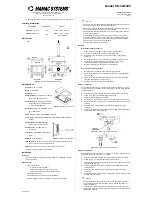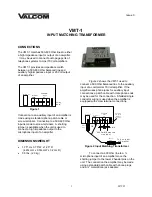
ENC-900 Operating Manual: Chapter 4 Configuration
27
Select a Network Address
and assign it to all units
which will be included in the
network.
Warning:
Encom Wireless
strongly recommends changing the
Network Address to a value
different from the factory default
before deploying the network.
Use the same Unit Address
on both units for point-to-
point mode. In multipoint
mode, set each Remote and
Repeater to a different Unit
Address.
Valid Unit Addresses are 1
to 65535.
S Register 104 - Network Address
The Network Address defines the membership to which individual units can
be a part of. By establishing a network under a common Network Address,
the network can be isolated from any other concurrently operating network.
As well, the Network Address provides a measure of privacy and security.
Only those units which are members of the network will participate in the
communications interchange. Valid values for the Network Address range
from 0 to 255, inclusive.
To enhance privacy and reliability of communications where multiple
networks may operate concurrently in close proximity, it is suggested that a
typical value be chosen – perhaps something meaningful yet not easily
selected by chance or coincidence.
Default is 1.
S Register 105 - Unit Address
In point-to-point operation, the Unit Address on both the Master and
Remote (or Repeater) units must be the same. In a multipoint system, the
Unit Address uniquely identifies each Remote and Repeater from one
another. Each unit in a multipoint system must have a unique Unit Address
ranging from 0 to 255.
S Register 106 - Primary Hopping Pattern
S Register 206 - Secondary Hopping Pattern
Since the ENC-900 is a frequency-hopping modem, the carrier frequency
changes periodically according to one of 64 pseudo-random patterns,
defined by the Primary and Secondary Hopping Patterns. Valid entries for
each are 0 through 63.
The concept of Primary and Secondary Hopping Patterns was introduced in
the discussion of S Register 101 (Operating Mode).
Using the designations M[a,] Rx[a,b] and Sx[a] where:
- M
indicates Master;
-
R
indicates Repeater;
-
S
indicates Remote;
-
x
is the Unit Address;
-
a
is the primary hopping pattern; and,
-
b
is the secondary hopping pattern;
Summary of Contents for ENC-900
Page 9: ...ENC 900 Operating Manual Chapter 2 Electrical Physical 5 ...
Page 17: ...ENC 900 Operating Manual Chapter 2 Electrical Physical 13 ...
Page 44: ...40 ENC 900 Operating Manual Chapter 4 Configuration ...
Page 46: ...42 ENC 900 Operating Manual Appendix A Modem Command Summary ...
Page 48: ...44 ENC 900 Operating Manual Appendix B Factory Default Settings ...
Page 50: ...46 ENC 900 Operating Manual Appendix C Technical Specifications ...
Page 54: ...50 ENC 900 Operating Manual Appendix E Approved Antennas ...
















































